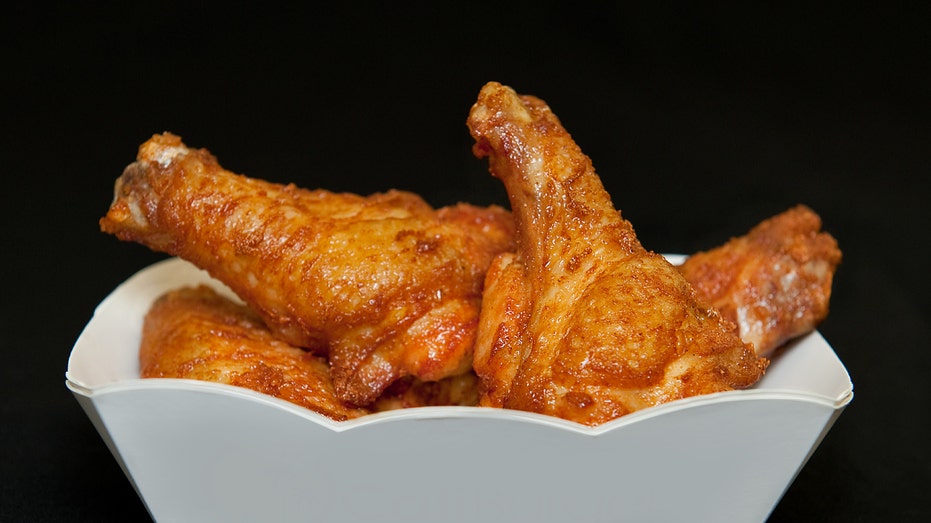Pricey chicken puts thighs on restaurant menus
Restaurants are finding ways to incorporate the less-popular dark meat amid short supplies of breasts and wings
Fox Business Flash top headlines for December 30
Check out what's clicking on FoxBusiness.com.
Short supplies and escalating costs of chicken breasts and wings are leading restaurants to add thighs and other dark poultry meat to menus and entrees.
Long overshadowed by more-coveted and profitable products like breasts and tenders, less-loved portions like thighs and legs have for years been directed toward export markets and lower-profile venues. Amid a national supply crunch that has doubled breast meat prices in 2021, sent wing markets to record levels and left some suppliers short on both, thighs have fresh appeal for meat companies and restaurant operators.
Poultry producer Perdue Farms Inc. has seen a 15% increase in boneless thigh sales in 2021 and a 20% increase in ground chicken, which is made of mostly dark meat, the company said.

A box of deep fried golden chicken wings (istock)
"That demand has been spectacular," said Mark McKay, president of fresh poultry and meats at the Salisbury, Md., company.
Products like thighs have two advantages for restaurants struggling with the high cost and tight supplies of breasts and tenders: they are cheaper and easier to get, industry officials said. Boneless skinless chicken breast, the poultry industry’s flagship product, was priced at under $1 a pound in late December 2020. Now, it is more than $2 a pound, according to market research firm Urner Barry. Thighs, meanwhile, cost about 54 cents a pound, compared with 26 cents a year earlier, according to the firm.
CHICKEN SHORTAGE IN US BEING BLAMED ON PANDEMIC, FRIED SANDWICH CRAZE
Mentions of thighs are growing on U.S. menus, though they remain rare. Around 2% of U.S. menus feature chicken thighs, according to industry research firm Technomic Inc. In comparison, 42% of menus list traditional chicken wings.
At Wing It On!, a 10-unit chain specializing in chicken, executives developed a plan to diversify its poultry supply as prices soared. Chief Executive Matt Ensero said he realized that while wings were coveted among restaurants, suppliers still had the rest of the bird to sell, making his account less attractive than other restaurant operators who bought more parts of the chicken.

In this Dec. 12, 2019, file photo workers process chickens at a poultry plant, in Fremont, (AP Photo/Nati Harnik, File / AP Newsroom)
"You think of the anatomy of the bird, and the wing itself is only 10%. That leaves 90% of the bird that producers have to find a home to," said Mr. Ensero, who estimated his chicken prices have climbed more than 200% from spring of 2020.
In late 2020, Mr. Ensero said, he approached his suppliers with a "whole bird strategy." He would figure out ways to serve more parts of the chicken if they would give him better terms. They agreed, and Mr. Ensero began selling "thigh wings" in addition to the chain’s traditional offerings last spring.
TACO BELL ADDING CHICKEN WINGS TO ITS MENU FOR ONE WEEK ONLY
Customer demand was a trickle in the beginning, and Mr. Ensero said he often gave the item away in orders to get his customers to try them. Wing It On! priced the new products at a discount to traditional wings, even though they had more than twice the meat.
Roughly seven months later, national chain Wingstop Inc. launched a "Thighstop" brand centered on chicken thigh products. The chain enlisted rapper and Wingstop restaurant owner Rick Ross to promote the dark-meat alternative, tweeting a photo of Mr. Ross reading a newspaper with a headline "Wing Shortage."

In this Dec. 2, 2008 file photo, a Pilgrim's Pride contract chicken farmer walks amid three-week-old chicks at a farm just outside the city limits of Pittsburg, Texas. (AP Photo/LM Otero, File)
"We also believe we can make thighs a center of the plate item," CEO Charlie Morrison told investors in November.
Mr. Ensero said Wing It On!’s thigh wing business shot up 40% after Wingstop’s foray into thighs. Wing It On! also sells white meat tenders and "Nuggz," and Mr. Ensero said the chain now buys about every part of the chicken but the legs.
Fast-casual chains such as Modern Market Eatery and Just Salad started adding thighs to their menus in late 2020, pitching the products as something different and more flavorful.
GET FOX BUSINESS ON THE GO BY CLICKING HERE
"Chicken thighs are all about flavor," said Nick Kenner, Just Salad’s chief executive. He said more customers are now choosing the product rather than the New York City-based chain’s chicken breast offerings.
Chicken suppliers are gearing up to sell more thighs and other dark-meat products to U.S. restaurants and grocery stores, executives said. Tyson Foods Inc. CEO Donnie King said in August that demand for the Arkansas-based meat giant’s boneless dark-meat chicken products is growing. The company recently said it plans to ramp up its automation capabilities for deboning dark-meat products.

The increased use of thigh and boneless dark-meat chunks gives food-service operations an alternative to wings and breast meat, a Tyson spokesman said.
Perdue’s Mr. McKay said that as more people began cooking from home during the pandemic, thighs and other poultry dark meat gained appeal with consumers looking for ways to make more creative, better-tasting meals. "Consumers want something more robust," he said.
CLICK HERE TO READ MORE ON FOX BUSINESS
Meat processors have an incentive to emphasize thighs and similar products to their U.S. customers, because the alternative often is to export those parts at a lower cost overseas, said Ben Bienvenu, a food and agribusiness research analyst at Stephens Inc.
"Boneless skinless thighs, in particular, have been growing steadily in demand for at least the past five years," he said. Meat companies are working with retailers to make products like thighs more popular, he said.
Mr. Ensero said that while wing prices have leveled off in recent weeks, he expects them to rise again during the college football playoffs and Super Bowl. He said he is sticking with thighs on Wing It On!’s menu.
"You have to sell it," he said. "We needed to create demand for this product."




















